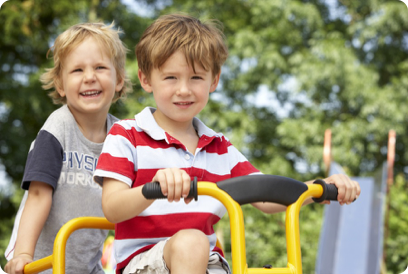
Social & Emotional Development
Our Social and Emotional Development curriculum is an underlying and pervasive component of our program. Research by the National Scientific Council on the Developing Child indicates that social competence and emotional wellbeing are critical to the young child's brain development, future school success, and emerging cognitive abilities.
Our teachers create an environment that actively supports the social and emotional development of each student. As a teacher responds respectfully to the child's needs and offers the child meaningful work that builds the child's self-esteem, the child develops a sense of trust in the teacher and a sense of belonging to the classroom community.
Overview of our Social and Emotional Development Curriculum:
1) Identifying and expressing feelings:
Young children need to be taught the vocabulary of emotions and feelings, and how to read facial expressions and body language. Our teachers read the children books about feelings, talk about their own feelings, and discuss emotions and feelings when conflict between students arises. In time, our students begin to:
- Identify their own feelings
- Identify the feelings of others
- Better control their impulses, frustration, and anger
- Use techniques for self-calming
2) Self-reliance, autonomy, and a sense of control:
Our teachers acknowledge each child's need for control, autonomy, and empowerment. A child's sense of control over his/her world grows as he/she becomes more and more self-reliant.
- In the classroom, our students are encouraged to be responsible for their own self-care, such as hanging up their coats, washing their hands, and dressing themselves.
- Our teachers also provide various jobs in the classroom, such as door holder, line leader, and calendar helper, to give each child opportunities to feel both powerful and helpful.
- When the child chooses and then completes a piece of work that is in his/her "just right learning zone", he/she gains confidence, self-esteem, and empowerment.
3) Grace, courtesy, and respect for others:
Our teachers use modeling
and guiding to teach each student basic etiquette, classroom
routines, and to think of others. Our students
practice polite greetings and introductions, making eye contact,
and raising their hands before speaking during circle
time. They are encouraged to develop respect for
others by sharing materials, waiting patiently for their turn,
and using polite phrases like "Please" and "Thank you".
4) Socializing, empathy, and conflict resolution:
Making friends, functioning as part of a group, cooperation, and conflict resolution are all important life skills included in our Social and Emotional curriculum. We begin each school year with "Getting Acquainted" activities that "break the ice" and help the students learn about the interests of one another. Our teachers also encourage an atmosphere of inclusion on the playground and help students learn how to:
- Invite others to play
- Join a group already at play
- Be resilient if their attempt to join a group is not successful
When conflicts between
students arise, our teachers use methods such as modeling and
role-playing to help the students involved identify the problem,
recognize the other child's perspective, and work toward an
acceptable solution. For younger children, the
teachers play an active role in conflict resolution, with the
goal in mind of giving each student the tools he/she needs to
problem solve and resolve conflicts with peers independently in
the future. Over time, our students gain an awareness
of both their own feelings and sensitivity for the feelings of
others.
5) Leadership:
As a student's social and emotional skills grow, he/she becomes a leader in the classroom to his/her younger classmates. Our older preschool and Kindergarten students often exhibit many of the following leadership behaviors:
- Modeling of appropriate classroom behavior
- Mediating in peer conflicts
- Nurturing and caring behaviors towards other students
- A greater acceptance of individual differences
- Teaching skills and lessons to younger students
Curriculum Quick Links
